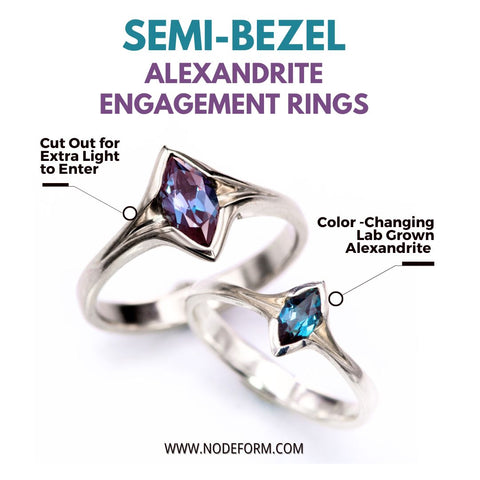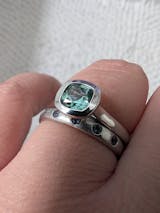
Stunning Alexandrite Rings That Will Take Your Breath Away
If you're looking for a truly unique and stunning addition to your jewelry collection, consider an alexandrite ring. These bold and mystical gemstones are known for their ability to change color in different lighting, ranging from green to purple to red. Explore our collection of alexandrite engagement rings and alexandrite accented wedding bands and discover the beauty and versatility of this rare gemstone.

What is Alexandrite?
Alexandrite is a rare and valuable gemstone that was first discovered in Russia in the 1830s. It is a variety of the mineral chrysoberyl and is known for its unique color-changing properties. In daylight or fluorescent light, alexandrite appears green or blue-green, but in incandescent light, it can appear red or purple. This phenomenon is known as "the alexandrite effect" and makes alexandrite a highly sought-after gemstone for jewelry. It is a magical gemstone that displays a beautiful color-changing looks.

Origin and Characteristics: Rarest Gemstones
Alexandrite is a variety of chrysoberyl, and what sets it apart is its remarkable ability to exhibit a striking color change. This gemstone was first discovered in the Ural Mountains of Russia in the 1830s and was named after Czar Alexander II. Its scarcity and unique properties make it highly prized among gem collectors and connoisseurs.
It is a rare gemstone that only occurs in nature in small quantities and has been mined for over 200 years. Natural high-quality alexandrites are very valuable and have been known to sell for up to $250,000 per carat! While we can source natural alexandrites for your custom ring designs, most of our designs use lab-grown alexandrites. Lab-created Alexandrites offer a wonderful alternative to the very rare and pricy genuine Alexandrite at affordable prices. Lab-grown alexandrites still show the famed color change beautifully and excellent faceting.

Three Stone Diamond Prong Set Engagement Ring with Alexandrite Side Stones
Color Change Phenomenon: Unique Color-Changing Properties
One of the most fascinating aspects of alexandrite is its remarkable color change under different lighting conditions. This phenomenon is known as pleochroism, where the gemstone appears green in natural daylight and transitions to a reddish-purple hue in incandescent light. This mesmerizing interplay of colors adds to the gem's allure and mystique.
Different Lighting Conditions
Alexandrite's color change is truly a sight to behold. In daylight, it showcases vibrant shades of green with subtle undertones of blue. As the light shifts to incandescent or artificial lighting, the gem transforms into rich purples, reds, and pinks. This versatility in color makes alexandrite a highly sought-after gemstone for jewelry pieces that captivate with their ever-changing hues.
Different Colors
The range of colors that alexandrite displays is simply astonishing. From lush greens reminiscent of emeralds to deep purples akin to amethysts, each shift in color tells a unique story. This natural kaleidoscope of hues makes alexandrite a gemstone like no other, offering a visual feast for the eyes with every glance.
Fluorescent Lighting
When exposed to fluorescent lighting, alexandrite may exhibit a mix of its daylight and incandescent colors, creating a delightful blend of greens and purples. This play of hues adds an enchanting dimension to the gemstone, making it a versatile and captivating choice for jewelry enthusiasts seeking something truly special.
In conclusion, alexandrite's rarity, color-changing properties, and captivating range of colors make it a standout choice for those looking for a unique and enchanting gemstone. Whether set in an engagement ring or worn as a statement piece, alexandrite continues to mesmerize with its otherworldly beauty and charm.
Alexandrite for Engagement and Wedding Rings
Thinking about choosing Alexandrite for your engagement or wedding ring? Let's dive into why Alexandrite could be an excellent choice for these special occasions.
Durability and Hardness: Mohs Scale of Hardness
Alexandrite gemstones score 8.5 on the Mohs scale, making them a durable option for everyday wear. It is slightly lower in hardness than a sapphire. This hardness level ensures that your Alexandrite ring will resist scratches and maintain its brilliance over many years if cared for properly.
Symbolism and Significance: Meaningful Choice
Symbolically, Alexandrite is associated with balance, joy, and good fortune, making it a meaningful choice for an engagement or wedding ring. As the birthstone for June, gifting an Alexandrite ring can represent new beginnings and prosperity. Its unique color-changing properties add a touch of magic to your special moment.
Availability and Cost: Lab Grown vs Natural Alexandrite
Natural Alexandrite is rare and valuable, known for its color-changing abilities under different lighting conditions. Lab-grown Alexandrite offers a more affordable option without compromising quality or beauty. Consider your preferences and budget when choosing between natural and lab-grown Alexandrite for your engagement or wedding ring.
Customization and Setting Options: Alexandrite Wedding Ring
When selecting an Alexandrite ring, explore various setting options to complement the gemstone's unique characteristics. Whether you prefer a classic white gold ring for a timeless look, a luxurious platinum ring for durability and sophistication, or a romantic rose gold ring for a warm and modern touch, there are endless possibilities to customize your Alexandrite engagement or wedding ring to reflect your personal style.
Make your engagement or wedding ring truly special by considering Alexandrite as a captivating and symbolic gemstone that represents love, transformation, and prosperity.
Pros and Cons of Alexandrite Engagement Rings
Alexandrite engagement rings are a unique and striking choice that offer both advantages and disadvantages. Let's explore the pros and cons of opting for an alexandrite stone as the centerpiece of your engagement ring.
Pros
- Color-changing Beauty: One of the most enchanting features of alexandrite is its remarkable color-changing ability. In different lighting conditions, this rare gemstone can shift hues from vibrant green to a deep purple, offering a captivating and dynamic display that is sure to stand out.
- Uniqueness: Alexandrite is a relatively rare gemstone, making it a distinctive choice for an engagement ring. Its scarcity adds to its allure and ensures that your ring will be a one-of-a-kind piece that is as unique as your love story.
- Symbolism of Change: The color-changing nature of alexandrite symbolizes adaptability and transformation, qualities that are often associated with relationships. Choosing an alexandrite engagement ring can signify a commitment to embracing change and growth together as a couple.
Cons
-
Durability Concerns: While alexandrite is a beautiful gemstone, it is not as hard as sapphires or diamonds, which are more commonly used in engagement rings. Due to its lower durability, alexandrite may be more prone to scratches and damage over time, requiring extra care and maintenance.
-
Cost: As a rare and prized gemstone, natural mined alexandrite is typically more expensive than other alternatives. The scarcity of high-quality alexandrite can drive up the cost of an alexandrite engagement ring, making it a significant investment compared to more traditional options. However, if you choose lab grown alexandrites you can keep your budget low that allows you to spend more time on your wedding or honeymoon.
Why should you choose an alexandrite ring instead of other gemstones
Color-changing properties: One of the most unique features of alexandrite is its ability to change color depending on the lighting conditions.which makes alexandrite a fascinating and captivating gemstone to wear. You'll never get tired of looking at your alexandrite rings.
Hardness: Alexandrite is a relatively hard gemstone, with a rating of 8.5 on the Mohs scale, just slightly lower than sapphire. This means that it is durable enough to be worn daily and can resist scratching and chipping. With proper care it will last many years in engagement rings and wedding bands.
Versatility: Alexandrite is a versatile gemstone that can be used in a variety of jewelry styles, from classic and traditional to modern and contemporary. It also pairs well with other gemstones, such as diamonds, moissanite and rubies, making it a great choice for multi-stone rings.

Emerald Cut Alexandrite Ivy Ring - Double Prong Set Split Shank Solitaire Engagement Ring
June Birthstone: Alexandrite is one of the birthstones for the month of June, along with pearl and moonstone. As a birthstone, alexandrite is believed to bring good luck, prosperity, and happiness to those who are born in June. It is also associated with qualities such as creativity, intuition, and imagination.
In addition to being a birthstone, alexandrite is often given as a gift to celebrate 55th wedding anniversaries. So, if you or a loved one were born in June, or are celebrating a 55th wedding anniversary, an alexandrite ring may be a particularly meaningful and appropriate choice.

Round Alexandrite Bezel Set Accented Cathedral Odette Engagement Ring
Caring for Alexandrite Rings
Taking proper care of your precious Alexandrite engagement ring is essential to maintain its beauty and durability. By following some simple cleaning and maintenance tips, as well as being cautious of potential damage, you can ensure that your ring retains its luster and brilliance for years to come.
Cleaning and Maintenance Tips:
When it comes to cleaning your Alexandrite ring, a soft-bristled brush and mild soapy water are all you need to keep it looking its best. Gently scrub the ring to remove any dirt or grime that may have accumulated. Avoid using harsh chemicals or abrasive cleaners, as these can damage the stone and metal.
Regular maintenance is also key to preserving the beauty of your ring. Consider taking your Alexandrite ring to a jeweler for professional cleaning and inspection at least once a year. This will help identify any potential issues early on and ensure that your ring stays in top condition.
Avoiding Potential Damage:
To prevent damage to your precious Alexandrite ring, it's important to take certain precautions. Avoid wearing your ring when engaging in activities that may expose it to harsh chemicals or physical impact, such as swimming in chlorinated pools or engaging in heavy manual labor.
Store your ring in a separate compartment in your jewelry box to prevent it from scratching against other pieces. When not wearing your ring, consider placing it in a soft cloth or pouch to protect it from dust and scratches.
By following these simple cleaning and maintenance tips, and being mindful of potential sources of damage, you can enjoy your stunning Alexandrite engagement ring for a lifetime.

























